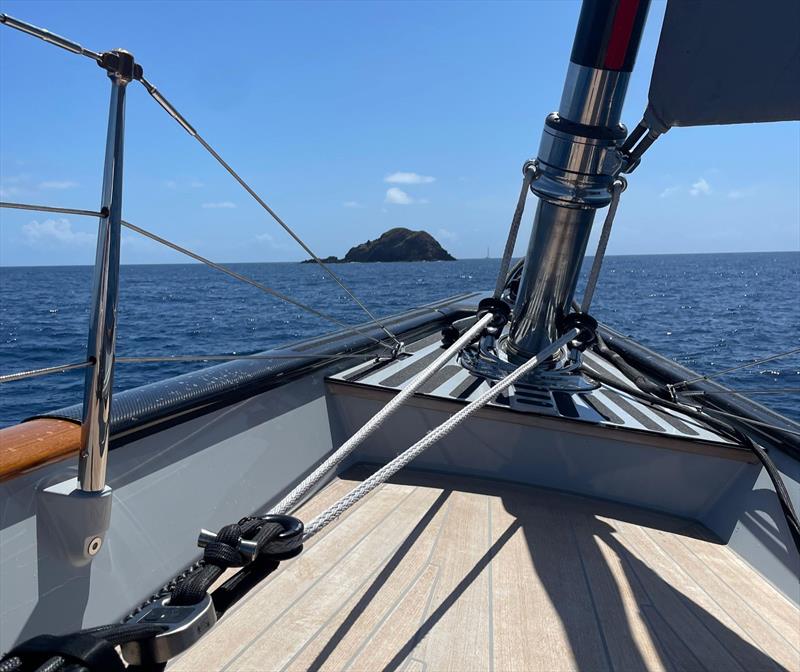
Stronger Superyacht Safety: smartlink ee Hits 20 Tonnes
by Cyclops Marine 25 Sep 2024 12:08 UTC

smartlink ee Hits 20 Tonnes © Cyclops Marine
Superyacht captains and owners are taking every measure possible to ensure safety, and monitoring technologies are the easiest, most reliable way to do this. There are a range of risk factors onboard a superyacht, and captains will keep an eye on multiple numbers and alerts. Escalating loads are some of the most critical.
Leader in wireless load sensing, Cyclops Marine provides highly accurate load sensing solutions to everyone from Olympic federations, to the majority of the teams in the America's Cup, all the way through to some of the world's most eminent superyachts.
While Cyclops made its name in the performance sailing world - empowering sailors to hit and repeat their fastest settings - their technology is now common on cruising boats, as sailors seek to avoid rig failure, improve safety, preserve equipment, and gain valuable data for service and maintenance checks. Their latest innovation brings these benefits to even more customers by catering for larger yachts and higher working loads. It also opens up more applications, like working at height, and monitoring tender towing systems and long lines ashore on large motor yachts.
smartlink 20t ee
smartlink 20t ee is the fourth in the ee range - which also includes 2t ee, 5t ee, and 10t ee - all offering secure "eye-to-eye" (ee) or pin-to-pin load sensing. This means the sensors can be directly fitted into ram forks without the need for additional strops, delivering secure, reliable, and incredibly accurate load sensing (to within 1% of maximum working load).
The introduction of the 20t ee means that Cyclops now offers a full suite of sensors for superyachts - providing solutions for virtually every application onboard.
Ultimate Versatility
The existing ee sensors are already being used by everyone from the classic classes (where they're popular on forestays) to IMOCA race teams (common on outriggers). The 20t ee sensor promises to widen that range even further. Ideal for countless standing and running rigging applications, whether performance-critical or essential for safety, it integrates seamlessly with backstays, vangs, jib tacks, main clews, shrouds, Ds, Vs, forestays, inner stays, and furlers (to name a few). smartlink ee is also already being used by multiple motor superyachts to monitor a range of critical lines, including tenders and long lines ashore.
It is also perfectly suited for hydraulic struts—ensuring applied loads stay safely within limits. While the rise of button-operated hydraulic rams has boosted convenience, it has also led to increased potential for overload. In the past, sailors would estimate load by the effort required to pump; now, with a simple button press on hydraulic backstays, massive loads can be generated, often unknowingly.
A Suite of Sensors for Superyacht Safety
Loads onboard superyachts reach very high levels, and with safety concerns escalating in parallel, smartlink 20t ee responds to a major industry need. Cyclops' smartlink range for soft rigging already reaches up to 20t max working load, but bringing big boat sensors to eye-eye fittings will empower captains and crew members with a new level of all around safety.
As well as sensors for soft rigging and pin-to-pin applications, Cyclops also offers Load Pins for standing rigging - in either wireless or digital direct iterations. When combined, sensors from across the range provide a complete picture of rig safety. Read about The Evolution of the Load Pin here.
While many captains are retrofitting Cyclops sensors, a range of boat yards are installing sensors on new builds, and many owners are opting to add them during service periods. Rig monitoring is rapidly becoming standard across the board. From cutting-edge performance superyachts like Baltic 111 'Raven'; state-of-the-art performance cruisers like the first Oyster 885GT 'Babiana'; and timeless classics like J-Class 'Rainbow'; to the world's largest aluminium sailing catamaran (floating art gallery 'ArtExplorer'): a massive range of large yachts have equipped themselves to meet rigorous performance and safety demands.
Seamless Connectivity and Data Management
Wirelessly connecting to your smartphone and onboard instruments, the sensors provide live feedback via Cyclops' intuitive app and through onboard displays. Keeping you in full control, they also offer adjustable data frequency—providing whatever level of detail you require.
Data is viewable both as raw numbers, and as a simple warning dial in green, amber, and red for safety applications.
For instance, when operating your hydraulic ram, simply push the button and watch the loads increase on-screen, or monitor the warning dial to ensure it never enters the red zone. The data is displayed simply and intuitively, so any member of the crew can understand it.
Cyclops is empowering sailors with the knowledge to sail smarter and safer. Discover solutions for superyachts here.
Discover solutions for superyachts here. Learn more about Cyclops, or get in touch with the experts for a consultation.